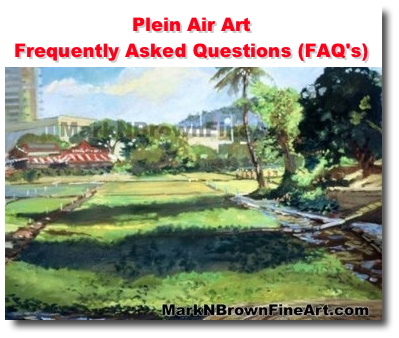FAQ's About Plein Air Students
- Tweet

What and Where Do I Paint Plein Air?
Your subject matter is entirely up to you, but remember that you don't have to paint everything you see; be selective, think about what the essence of the scene is. Focus on what you see, not what you can imagine or intellectualize about the subject (otherwise you may as well be back in your studio).
Consider scouting out locations in advance to decide what you're going too paint and where you would set up. This way when you head out to paint you can spend the whole day painting and take along the best selection of colors for that particular scene. Look right around, 360 degrees, so you don't miss the possibilities 'behind' you.
Don't think that it needs to be somewhere far away or exotic, you can go to a local park, to a friend with a lovely flower garden, or even set up your watercolors on a table in a coffee shop. The ideal spot to set up will be in the shade, out of the wind, but this often isn't possible. If you use an umbrella for shade, be sure that it doesn't cast any color on your canvas.
How to Deal With Spectators While Painting Plein Air
There are many great places to pain in Hawaii. Parks, beaches, mountain tops...There's something about seeing an artist at work that makes people extremely inquisitive, more likely to talk to a stranger, and prone to giving unwanted opinions. It can be disconcerting, especially if your painting isn't going well, and quite disruptive. Considering positioning yourself where people can't come up behind you, such as against a wall or in a closed doorway. If you don't wish to chat, be politely non-responsive along the lines of "I'm sorry I can't talk right now I've only a limited time to do this". Or choose a less public place, like a mountain or your own backyard!
How to Cope with Changing Light When Painting Plein Air
The scene in front of you will change as the sun moves across the sky. For example, strong shadows in the early morning will shrink as lunchtime approaches. Start by putting in the main shapes across the whole painting and then the detail. If you work slowly and can be in the same spot for several days, consider having different canvasses to record the scene at different times and create a series of paintings. As the day progresses, change from one canvas to the next.
Do I Have to Finish the Painting Outdoors?
Purists will argue that a plein-air painting needs to be started and finished outside the studio, but surely it's the end result that counts, not simply where you created it? If you prefer to sketch or make preparatory paintings to work up in the studio, do so.
What Art Materials Do I Need to Take With Me for Plein Air Painting?
See my Plein Air Painting Checklist for what art materials to take on location with you as well as essential non-painting items. If you can afford to, keep a separate set of supplies for plein air painting to make it easy to pick up and go, rather than having to pack every time.
Is It Safe to Take My Paints on a Plane?
Despite the fact acrylic and oil paints are non-flammable, it's best to pack them into your bag that will be checked in rather than carry it in your hand luggage and risk having some overzealous security guard confiscate them because they don't believe you. Also put your brushes and palette knives in your checked baggage as they could be considered potential weapons. Mediums, turpentine, and mineral spirits should generally be regarded as hazardous and not be taken on a plane; buy them at your destination. If in any doubt, try to get hold of a product information sheet and check with the airline.
Do I Need an Easel for Plein Air Painting?
There's a variety of sketching or portable easels on the market which are light to carry and fold up quite small, but you could simply prop up your board on something, such as the bag you carry your art materials in. If you're painting from your car (an idea when it's raining) you could prop it up on the dashboard. First see how much you enjoy plein air painting before investing in another easel.
How Do I Transport Wet Canvases?
Unless you've space in your car to put a canvas down flat, this can be tricky. If you're using oils, try to use a medium that speeds up drying. A French easel may enable you to attach a canvas to it for transporting back home. Some art stores sell clips that can be attached to canvases to separate them; put the 'wet' edges to the inside, with the 'dry' edges outwards. If you're happy painting smallish pictures, consider a pochade box, a nifty, compact box which holds several wet panels in the lid and your paints in the bottom; a palette keeps your paints in place and slides out when you want to use it. Be sure to consider where and how long you will be parking your car with supplies.
ref no:18274
Please send questions about this website to webmaster
Terms of Use / Legal Disclaimer / Privacy Statement
Site Designed and Managed by MacBusiness Consulting
